End of cycle in California. A dozen storms since December have achieved something unimaginable just a few months ago: A state known for its water scarcity will say goodbye to a devastating drought. Passing conditions, known as atmospheric rivers, have filled reserves and eased the burden on thousands of farmers at the center of the company. This Friday, the state government announced that the fifty arrangements made in the last two years to conserve water have ended.
“Is the drought over in California? It feels that way, and I want to make sure it stays that way, but it’s still complicated,” Governor Gavin Newsom said this Friday. The local president has opted for caution after years of demanding 40 million Californians cut water consumption during the three driest years on record since 1896, when they began counting. “I know it’s disappointing to some people that it would be great if the governor said, ‘The drought is over,'” added Newsom, from Dunnigan, an area north of Sacramento that grows rice and almonds, two crops that require large amounts of water to thrive.
Most of California is no longer experiencing these drought conditions, the Department of Agriculture indicated in its weekly report. It occupies 36% of its territory. This is a drastic change compared to three months ago when the entire state was affected. Atmospheric rivers have brought rainfall that is well above the average rainfall for the season. The same thing happens in snow. The average for this year is 223% of the annual average with hilly formations. This is an important indicator to continuously develop water deposits in summer and autumn. “This is good news,” said California Secretary of Natural Resources Wade Crowfoot.
Twelve of California’s seventeen dams exceeded the historical average for this year. Deposits are at a three-year high, so the government has announced it will take 75% of the delivery to districts serving 27 million people. Last year, state authorities contributed only 5% of the network. As a result, strict restrictions were imposed to reduce consumption in most districts. This year’s contribution was the largest since 2017, when severe storms ended a six-year drought. Three years later the situation was reversed.
Newsom is shutting down a total of 48 water conservation measures today. One of them, announced in October 2021, called for a voluntary effort by Californians to reduce demand on the network by 15%. It’s a failure. Supply savings did not reach 6% in January. The Governor has taken 33 more measures to avoid wastage. After 48 hours of rainfall, irrigation is prohibited, including the use of hoses and the use of water on ornamental grass in commercial areas and businesses.
Although conditions have improved, the government maintains a state of emergency, allowing it to act quickly and tackle the effects of three years of drought in the region. However, two areas in particular have been affected by the drought, officials said. One of these is the border between Oregon and California, whose supply depends on the Klamath River, which has not benefited from the storms. Something similar is happening with the Colorado River, which feeds a good portion of Southern California. The state is affected by its underground deposits. 62% of its wells have been overexploited in recent years and are below normal.
California is bracing for extreme weather conditions. “The extreme weather we’ve experienced in recent months makes it very clear to us that we and our water system must adapt to the impacts of drought and flooding,” Newsom said at a press conference. A new storm is forecast to roll into the area next week, which could bring fresh flooding, knocking winds and pushing dams to their limits. Those are images that would have been impossible just a few months ago.

“Music ninja. Analyst. Typical coffee lover. Travel evangelist. Proud explorer.”

:quality(85)/cloudfront-us-east-1.images.arcpublishing.com/infobae/TEQF6EONZRFGLLLDIDD4L2O4EE.jpg)

:quality(75)/cloudfront-us-east-1.images.arcpublishing.com/elcomercio/XU32LRAEZFDDPNVHLFU3CKVBYY.jpg)



More Stories
Earthquake in the US today, Wednesday, May 29 – Earthquake’s exact time, magnitude and location via USGS | USGS | composition
President Arrivalo is left with no alternatives to dismissing the Attorney General
Passenger dies after jumping off world’s largest cruise ship in Florida